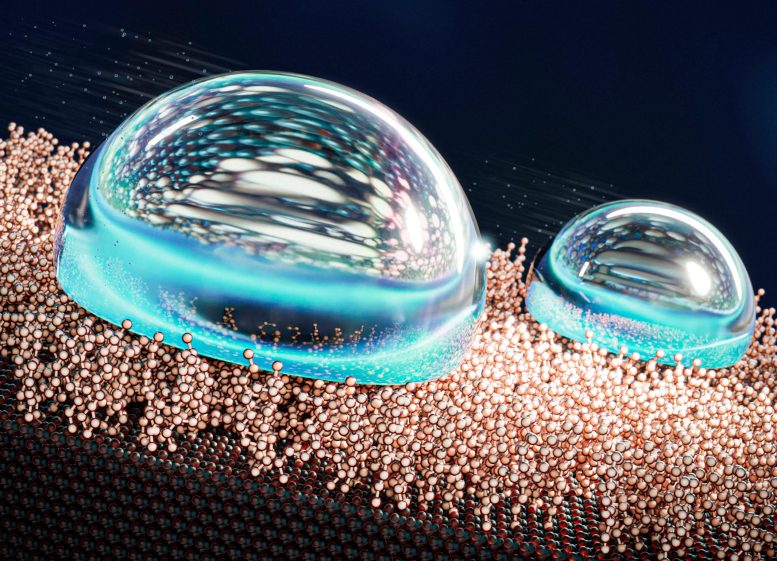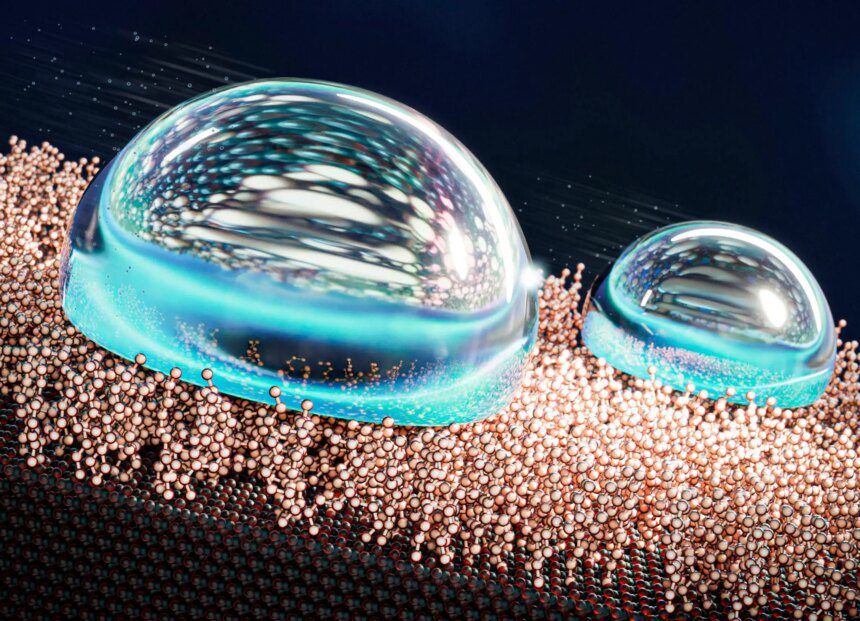
Artist’s depiction of the liquid-like layer of molecules repelling water droplets. Credit: Ekaterina Osmekhina/Aalto University
A revised method for creating hydrophobic surfaces has implications for any technology where water meets a solid surface, from optics and microfluidics to cooking.
Researchers have developed a new mechanism that allows water droplets to slide off surfaces, described in a paper published in Natural chemistry. The discovery challenges existing ideas about friction between solid surfaces and water and opens a new avenue for studying droplet slipperiness at the molecular level. The new technique has applications in many fields, including plumbing, optics, as well as the automotive and maritime industries.
Interactions of water and solid surfaces
All around us, water is always interacting with solid surfaces. Cooking, transportation, optics and hundreds of other technologies are affected by how water sticks to or slides off surfaces. Understanding the molecular dynamics of these microscopic droplets helps scientists and engineers find ways to improve many household and industrial technologies.
Liquid-like surfaces are a new type of anti-droplet surface that offer many technical advantages over traditional approaches. recently reviewed In Nature Comments Chemistry by Robin Ras, professor at Aalto University. They feature molecular layers that are highly mobile but covalently bonded to the substrate, giving the solid surfaces a liquid-like quality that acts as a layer of lubricant between the water droplets and the surface itself. A research team led by Ras used a specially designed reactor to create a liquid-like layer of molecules, called self-assembled monolayers (SAM), on top of a silicon surface.
Watching the growth of self-assembled monolayers
“Our work is the first time that someone has gone directly to the nanoscale to create molecularly heterogeneous surfaces,” explains doctoral student Sakari Lepikko, lead author of the study.
By carefully adjusting conditions such as temperature and water content inside the reactor, the team was able to fine-tune the amount of silicon surface area covered by the monolayer.
“I find it very exciting that by integrating the reactor with an ellipsometer, we can observe the growth of self-assembled monolayers with an extraordinary level of detail,” says Ras.
“The results showed more slipperiness when SAM coverage was low or high, which are also the situations where the surface is most homogeneous. At low coverage, silicon surface is the most prevalent component, and at high coverage, SAMs are the most prevalent.
“It was counterintuitive that even low coverage gave rise to exceptional slipperiness,” Lepikko continues.
At low coverage, water forms a film on the surface, which increases friction. “We found that instead, water flows freely between SAM molecules at low SAM coverage, slipping off the surface. And when SAM coverage is high, water stays above the SAM and slides off just as easily. It is only between these two states that water adheres to the SAM and adheres to the surface.
The new method proved exceptionally effective, as the team created the world’s slipperiest liquid surface.
Anti-fog, defrost, self-cleaning
This discovery promises to have implications wherever anti-droplet surfaces are needed. According to Lepikko, this covers hundreds of examples ranging from everyday life to industrial solutions.
“Things such as heat transfer in pipes, defrosting and antifogging are potential uses. It will also facilitate microfluidics, where tiny droplets must be moved smoothly, and the creation of self-cleaning surfaces. Our counterintuitive mechanism constitutes a new way to increase droplet mobility wherever it is needed,” explains Lepikko.
Next, the team plans to continue experimenting with its self-assembling single-layer configuration and improve the layer itself. Lepikko is particularly excited about the insights this work has provided for future innovations.
“The main problem with a SAM coating is that it is very thin and therefore easily disperses after physical contact. But studying them gives us fundamental scientific knowledge that we can use to create lasting practical applications.
The research used the national OtaNano research infrastructure and was carried out by the Soft Matter and Wetting group in the Department of Applied Physics, which also produced other pioneering water-repellent materials.
Reference: “Droplet slipperiness despite surface heterogeneity at the molecular scale” by Sakari Lepikko, Ygor Morais Jaques, Muhammad Junaid, Matilda Backholm, Jouko Lahtinen, Jaakko Julin, Ville Jokinen, Timo Sajavaara, Maria Sammalkorpi, Adam S. Foster and Robin HA Ras, October 23, 2023, Natural chemistry.
DOI: 10.1038/s41557-023-01346-3
Researchers from the University of Jyväskylä also contributed to this study.











